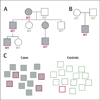A roadmap to investigate the genetic basis of bicuspid aortic valve and its complications: insights from the International BAVCon (Bicuspid Aortic Valve Consortium)
- PMID: 25145529
- PMCID: PMC4485610
- DOI: 10.1016/j.jacc.2014.04.073
A roadmap to investigate the genetic basis of bicuspid aortic valve and its complications: insights from the International BAVCon (Bicuspid Aortic Valve Consortium)
Abstract
Bicuspid aortic valve (BAV) is the most common adult congenital heart defect and is found in 0.5% to 2.0% of the general population. The term "BAV" refers to a heterogeneous group of disorders characterized by diverse aortic valve malformations with associated aortopathy, congenital heart defects, and genetic syndromes. Even after decades of investigation, the genetic determinants of BAV and its complications remain largely undefined. Just as BAV phenotypes are highly variable, the genetic etiologies of BAV are equally diverse and vary from complex inheritance in families to sporadic cases without any evidence of inheritance. In this paper, the authors discuss current concepts in BAV genetics and propose a roadmap for unraveling unanswered questions about BAV through the integrated analysis of genetic and clinical data.
Keywords: bicuspid; consortium; roadmap; valve.
Copyright © 2014 American College of Cardiology Foundation. Published by Elsevier Inc. All rights reserved.
Figures



References
-
- Siu SC, Silversides CK. Bicuspid aortic valve disease. J Am Coll Cardiol. 2010;55:2789–2800. - PubMed
-
- Fedak PW, Verma S, David TE, Leask RL, Weisel RD, Butany J. Clinical and pathophysiological implications of a bicuspid aortic valve. Circulation. 2002;106:900–904. - PubMed
-
- Brenner JI, Kuehl K. Hypoplastic left heart syndrome and other left heart disease: evolution of understanding from population-based analysis to molecular biology and back again—a brief overview. Cardiol Young. 2011;21(Suppl 2):23–27. - PubMed
Publication types
MeSH terms
Grants and funding
LinkOut - more resources
Full Text Sources
Other Literature Sources
Medical

